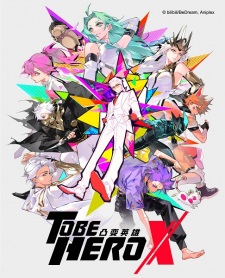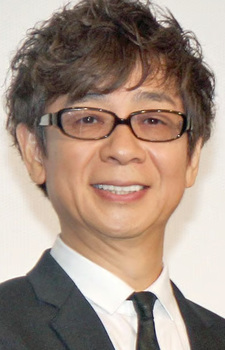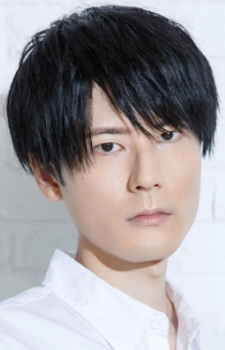
Tu Bian Yingxiong X
Summary: This is a world where heroes are created by people's trust, and the hero who has received the most trust is known as "X." In this world, people's trust can be calculated by data, and these values will be reflected on everyone's wrist. As long as enough trust points are obtained, ordinary people can also have superpowers and become superheroes that save the world. However, the ever-changing trust value makes the hero's path full of unknowns...
(Source: Bilibili, translated)
Description
This is a world where heroes are created by people's trust, and the hero who has received the most trust is known as "X." In this world, people's trust can be calculated by data, and these values will be reflected on everyone's wrist. As long as enough trust points are obtained, ordinary people can also have superpowers and become superheroes that save the world. However, the ever-changing trust value makes the hero's path full of unknowns...
(Source: Bilibili, translated)
Available At
Warning: Array to string conversion in /home/hianime.me.uk/public_html/anime.php on line 243
Array
Warning: Array to string conversion in /home/hianime.me.uk/public_html/anime.php on line 243
Array
Tu Bian Yingxiong X Trailers
Tu Bian Yingxiong X Pictures
Tu Bian Yingxiong X Review
Tu Bian Yingxiong X — This is a world where heroes are created by people's trust, and the hero who has received the most trust is known as "X." In this world, people's trust can be calculated by data, and these values will be reflected on everyone's wrist. This overview is intentionally spoiler-free and focuses on tone and intent rather than plot specifics.
Thematically, It sits firmly within Action conventions as a ONA work and has garnered attention (MAL score: 8.73). This work explores character dynamics, tonal shifts, and the interplay between narrative ambition and execution. The story's pacing and tonal choices are crafted to complement the central ideas, often emphasizing atmosphere and emotional truth over explicit exposition. The show's ability to evoke a consistent mood — whether melancholic, exuberant, or contemplative — is a recurring strength, and the scenes are constructed so viewers can infer stakes without needing explicit spoilers.
Characterization is a core pillar here. Protagonists and supporting figures are written with distinct motivations and narrative roles; even when archetypal, the series invests in small behavioral details that make choices feel earned. Character arcs are handled with an eye for gradualism: development often arrives through incremental beats rather than abrupt, expository shifts. The interactions between characters create texture, and relationships are used to illuminate both personal flaws and larger thematic concerns.
On the visual front, production values play a significant role. The animation quality varies by sequence but frequently showcases thoughtful direction and composition. Background art, framing, and color palettes are used deliberately to support tone — quieter scenes favor muted palettes while action or heightened emotional beats employ brighter, more kinetic visuals. Direction choices, such as camera movement and shot selection, often elevate scenes beyond their raw script, creating moments that linger in the viewer's mind.
The soundscape — score, incidental music, and sound design — complements the visual language. Music cues are placed to maximize emotional resonance without manipulating the audience with melodrama; this restraint often leads to more authentic emotional payoff. Sound design punctuates key moments, and when the series leans on silence, those quieter moments are given weight by measured audio choices.
Pacing and structure are handled with craft. Episodes are arranged to build tension and release methodically, and the narrative rarely rushes through important emotional beats. That said, the deliberate pacing may feel slow to viewers who prefer faster plot turnover; the reward is greater nuance and an accumulation of meaning across the series. Accessibility is generally good — one can appreciate surface-level pleasures, while repeat or attentive viewing reveals additional layers.
No title is without flaws. Occasional unevenness in subplots or variable animation across episodes can be distracting. Some tonal shifts might feel abrupt if you expect uniformity; others will argue that those shifts are purposeful. These are worth noting, but they seldom undercut the larger achievements of the work.
In sum, Tu Bian Yingxiong X offers a rich experience for viewers who value character-driven storytelling, considered visual design, and a soundtrack that supports rather than overwhelms. For fans of Action, this is an especially rewarding watch. It's recommended for those who appreciate layered narratives and artistry in animation, and best approached with patience and attention to nuance.
Characters & Voice Actors

Ahu
Main

Ahu
Main

Ahu
Main

Ahu
Main

Ahu
Main

Ahu
Main

Dragon Boy
Main

Dragon Boy
Main

Dragon Boy
Main

Dragon Boy
Main

Dragon Boy
Main

Dragon Boy
Main

Dragon Boy
Main

Ghostblade
Main

Ghostblade
Main

Ghostblade
Main

Ghostblade
Main

Ghostblade
Main

Ghostblade
Main

Lin, Ling
Main
Staff

Li, Haoling
Director, Original Creator

Anderson, Benjamin
Theme Song Lyrics

Rei
Theme Song Performance

Sawano, Hiroyuki
Theme Song Arrangement, Theme Song Composition, Music

SennaRin
Theme Song Performance

Bodart, Michaël
ADR Director

Chauvier, Delphine
ADR Director

Fajardo, Emily
ADR Director

Fukasawa, Hideyuki
Music

Jara, Betzabé
ADR Director

Kenmochi, Hidefumi
Music

Mutsuki, Shuuhei
Music

Santhos, Leonardo
ADR Director

Takada, Ryuuichi
Music

Umase, Misaki
Music

Yamamoto, Kohta
Music

Zhang, Jie
ADR Director